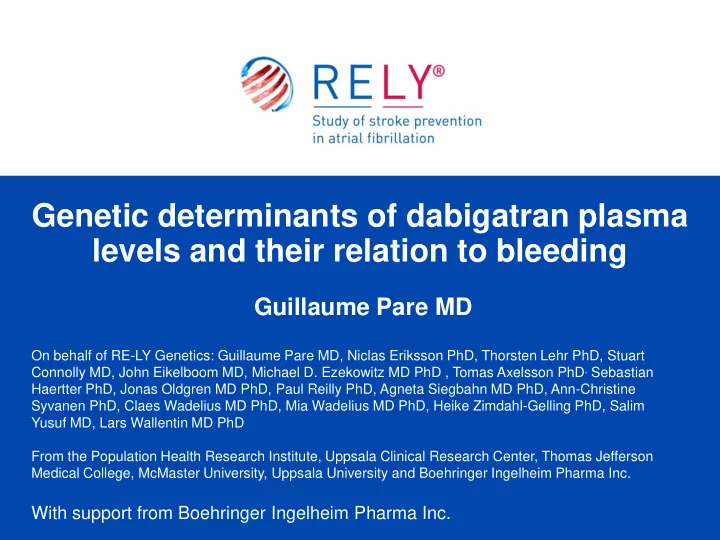

Genetic determinants of dabigatran plasma levels and their relation to bleeding Guillaume Pare MD On behalf of RE-LY Genetics: Guillaume Pare MD, Niclas Eriksson PhD, Thorsten Lehr PhD, Stuart Connolly MD, John Eikelboom MD, Michael D. Ezekowitz MD PhD , Tomas Axelsson PhD , Sebastian Haertter PhD, Jonas Oldgren MD PhD, Paul Reilly PhD, Agneta Siegbahn MD PhD, Ann-Christine Syvanen PhD, Claes Wadelius MD PhD, Mia Wadelius MD PhD, Heike Zimdahl-Gelling PhD, Salim Yusuf MD, Lars Wallentin MD PhD From the Population Health Research Institute, Uppsala Clinical Research Center, Thomas Jefferson Medical College, McMaster University, Uppsala University and Boehringer Ingelheim Pharma Inc. With support from Boehringer Ingelheim Pharma Inc.
Background Dabigatran etexilate is effective and safe in prevention of stroke in AF patients compared with warfarin Dabigatran etexilate is an oral prodrug that is rapidly converted by esterases (CES1) to the active agent dabigatran We hypothesized genetic factors are responsible for some of the inter-individual variability in dabigatran exposure
RE-LY Trial AF patients with at least one additional RF for stroke 18,113 patients with median follow-up of 2.0 years Randomized trial of two fixed doses of dabigatran etexilate (110 and 150 mg bid) and open-label warfarin 110 mg as effective as warfarin 150 mg superior to warfarin Both doses had lower minor and major bleeds
Methods Summary Genome-wide analysis (551,203 markers) of dabigatran peak and trough concentration (N=1,490) Identification of genetic determinants of peak and trough concentration Association testing of genetic determinants of dabigatran concentration with safety and efficacy outcomes (N=1,694)
Methods Primary efficacy endpoint defined as stroke or systemic embolism Primary safety endpoint define as any bleeding, minor and major 1,694 dabigatran etexilate-treated RE-LY participants of European ancestry successfully genotyped Illumina Human610-quad beadchip (551,203 SNPs passed QC) 807 warfarin-treated participants also genotyped 1,490 participants also had peak (1 to 3H) and trough concentrations measured by HPLC-MS/MS
Study Population Warfarin Dabigatran 110 mg Dabigatran 150 mg Baseline characteristics N 807 849 845 Age 72.2 (7) 71.7 (7.5) 71.9 (7.6) Female (%) 273 (33.8%) 259 (30.5%) 272 (32.2%) BMI (Kg/m 2 ) 29.4 (5.6) 28.9 (5.7) 29.2 (5.3) CHADS2 2.0 (1.1) 2.0 (1.2) 2.0 (1.1) History of Stroke (%) 83 (10.3%) 91 (10.7%) 77 (9.1%) History of Diabetes (%) 158 (19.6%) 178 (21.0%) 159 (18.8%) Aspirin Use (%) 228 (28.3%) 265 (31.2%) 234 (27.7%) Dabigatran concentration Number with measurements (%) - 752 (88.6%) 738 (87.3%) Trough Concentration (ng/mL) - 73 (48) 105 (72)* Peak Concentration (ng/mL) - 156 (94) 220 (133)* Events Ischemic Stroke or Systemic Emboli (%) 12(1.5%) 15(1.8%) 17(2.0%) Any Bleed (%) 325(40.3%)* 289(34.0%) 298(35.3%) Major Bleed (%) 45(5.6%) 49(5.8%) 52(6.2%) Minor Bleed (%) 306(37.9%)* 270(31.8%) 275(32.5%)
Peak and Trough Concentration GWAS Fold Change per Chromosome Position MAF SNP Locus Function P-Value Minor Allele (bp) (Allele) (95%CI) Peak Concentration 8.2 x 10 -8 rs4148738 7 87000985 ABCB1 Intron 0.45 (G) 1.12 (1.08-1.17) rs8192935 16 54419295 CES1 Intron 0.33 (A) 0.88 (0.84-0.92) 3.2 x 10 -8 Trough Concentration rs4580160 16 54326141 CES1P2 Intron 0.30 (A) 0.88 (0.84-0.92) 1.7 x 10 -8 rs2244613 16 54402110 CES1 Intron 0.18 (C) 0.85 (0.81-0.90) 1.2 x 10 -8 - MAF: Minor allele frequency - Linear regression with adjustment for dose, age, sex, BMI, CrCl, PPI, P-gp inhibitor use and first 10 principal components - Additive genetic model (gene-dose effect) - Significance set at P < 9 x 10 -8
ABCB1 Locus – Peak Concentration -Log10( P- value)
CES1 Locus – Peak Concentration -Log10( P- value)
CES1 Locus – Trough Concentration -Log10( P- value)
Association with Events rs4148738 rs8192935 rs2244613 ( ABCB1 ; Peak concentration) ( CES1 ; Peak concentration) ( CES1 ; Trough concentration) Event OR (95%CI) * P OR (95%CI) * P OR (95%CI) * P Ischemic Stroke or Systemic embolism 0.88(0.53-1.46) 0.62 0.76(0.43-1.34) 0.34 0.70(0.33-1.47) 0.34 7x10 -5 Any Bleeding 0.94(0.82-1.09) 0.44 0.89(0.76-1.03) 0.13 0.67(0.55-0.82) Major Bleeding 1.14(0.85-1.52) 0.40 0.88(0.64-1.21) 0.44 0.66(0.43-1.01) 0.06 4x10 -4 Minor Bleeding 0.94(0.81-1.09) 0.38 0.89(0.76-1.05) 0.17 0.70(0.57-0.85) - *: Odds ratio per minor allele (gene-dose effect) - Logistic regression with adjustment for dose, age, sex, CHADS2, ASA, CrCl and first 10 principal components - Significance set at P < 0.05
Survival Analysis Freedom from bleed according to rs2244613 carrier status
Conclusions ABCB1 and CES1 loci are associated with dabigatran concentration Dabigatran etexilate is a substrate of ABCB1 CES1 is responsible for the biotransformation of dabigatran etexilate into dabigatran 32.8% of Europeans are carriers of the CES1 SNP rs2244613 Each minor allele is associated with 15% decrease in trough concentration Carriers have 27% decrease in relative risk of bleed 14% decrease in relative risk of bleed for low vs high dose of dabigatran etexilate in the parent study No association with efficacy – but modest statistical power
Thanks! Population Health Research Institute, Uppsala Clinical Research Center, Thomas Jefferson Medical College, McMaster University, Uppsala University and Boehringer Ingelheim Pharma Inc.
Recommend
More recommend